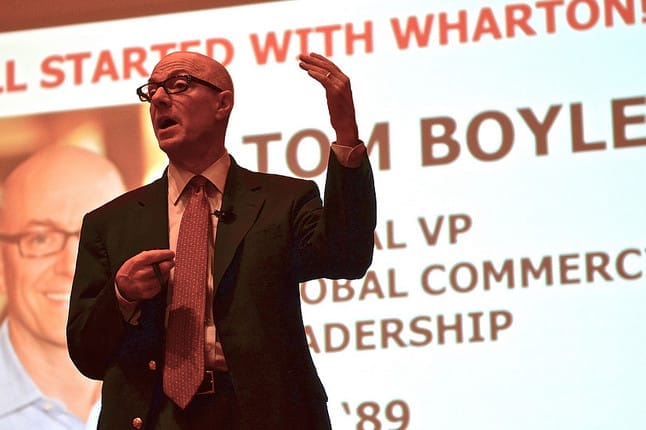Are chief information officers and chief marketing officers friends or “frenemies”?
Do marketers now have too much data at their disposal?
With social media, should we learn to trust and base decisions off qualitative indications again?
Is there such a thing as multicultural marketing anymore?
Get a room of marketing MBAs together with senior-level practitioners, and questions are bound to be raised. Such was the case with “The New Era of Marketing: Globalization, Analytics and Choice,” the 2013 Wharton Marketing Conference held in Philadelphia Nov. 8. Very senior marketers—such as Tom Boyle, WG’89, vice president, marketing and commercial leadership, at the Coca-Cola Co., and Callie Canfield, director of marketing and communications at BHLDN, shared the stage with faculty heavyweight David J. Reibstein, Wharton’s William S. Woodside Professor, to discuss bringing wedding dress shopping to the online market.

A panel at the 2013 Wharton Marketing Conference featuring Lauventria Robinson, WG’87, Vice President, Multicultural Marketing, Coca-Cola North America Group; Sara Larsen, VP of Digital Marketing and Campaigns, SAP; Cyrille Labourel, Senior Brand Manager, CLEAN&CLEAR, Johnson & Johnson; and Jody Shapiro, WG’09, Head of Product Management, Google Analytics Premium (left to right)
It was one of those events too dense to distill into 500 or so words, but that’s what I am here to do. So let’s get back to those questions:
1. CMO vs. CIO
It’s a lively debate in the “real world,” and the answer to who is ascendant—the chief marketing officer or chief information officer—is company-by-company. Jody Shapiro, WG’09, head of product management at Google Analytics Premium, delivered an astute message to both executives: essentially, you’re on the same team.
Marketing is “no longer a check mark approval,” he said. Marketers need proof (read: data) to prove that their strategies will work, and they need to be able to tune and retune messages on the fly. It’s only practical that they need the technology know-how of a CIO to help them get the analytics tools they need and that the two drive business together.
2. Too much data
Speakers, plural, at the conference wondered aloud about “paralysis by analysis” and other dangers of having big data at their disposal.
Linda Shein, W’82, managing director of Wharton’s Jay H. Baker Retailing Center, offered advice here. Use data to test specific hunches and answer particular questions.
3. Such a thing as a “qual”?
Quants have seemingly taken over the world, but as more marketers attempt to make sense of their customers’ social media chatter, qualitative insights still retain power. Lauventria Robinson, WG’87, vice president of multicultural marketing at Coca-Cola North America Group, mentioned how Coca-Cola picked the brains of “influential” consumers—hip individuals that could give a peek into what was about to get cool in popular culture.
“There is no quant at all in that type of information,” she said.
4. Multicultural, Targeted or Total?
Traditional brand marketing is evolving, according to Robinson. In five years, the role of multicultural marketing departs will evolve as they will play a greater center-of-excellence role, ensuring that “all” marketing will become more multicultural. The focus will be on a combination of “Total” and “Targeted” marketing, such that Total becomes the new “Marketing 101” and integrates a universal message that reflects multicultural insights. Targeted marketing will reflect unique and distinct cultural differences.
Robinson recalled a PowerAde commercial that featured young athletes playing soccer in a basketball court. Coca-Cola aimed it at young “bicultural” Hispanic consumers but discovered that the urban vibe resonated with multicultural teens, period.
Editor’s note: We are sorry to report that the author is over his 500 word limit. Please excuse the abrupt ending of his “distillation” of the marketing conference. Visit the Wharton Flickr channel for more photos from the 2013 Wharton Marketing Conference.


























